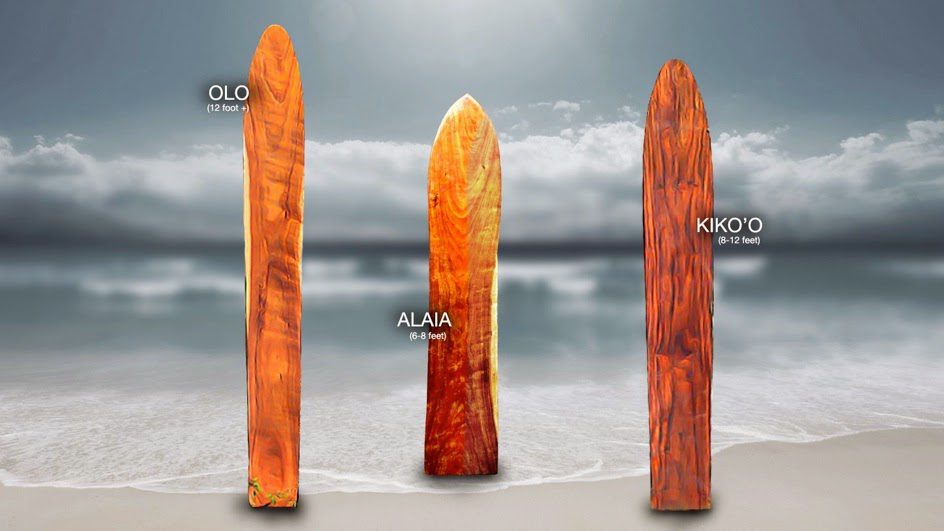History
Riding the Waves of History: The Olo, Kiko’o, and Alaia Surfboards That Shaped Hawaii
Image Courtesy of Hanging10by10
Picture yourself on a sun-drenched Hawaiian shore centuries ago, the roar of the Pacific in your ears as a massive wave looms on the horizon. A Hawaiian chief charges it on a towering Olo surfboard, a daring surfer slashes across the face on a sleek Kiko’o, and a commoner dances with the sea on a nimble Alaia. These weren’t just planks of wood—they were vessels of culture, skill, and raw exhilaration, born from Hawaii’s deep bond with the ocean. Let’s dive into the thrilling origins of the Olo, Kiko’o, and Alaia surfboards and uncover how they carved the path for modern surfing.
The Olo: The Royal Titan of the Waves
Imagine a surfboard fit for a king—literally. The Olo, stretching 16 to 20 feet long and weighing up to 150 pounds, was the ultimate ride for Hawaiian chiefs, the Ali’i. Crafted from lightweight wiliwili wood—or occasionally koa or ula—these finless behemoths were designed to dominate massive swells, even tsunamis. Reserved for royalty, the Olo was more than a board; it was a symbol of power and a sacred link to the sea gods.
Riding one was a spectacle of strength and courage. Without fins, surfers steered with pure muscle, lying prone or standing tall as they sliced through towering waves. Feel the adrenaline: the board rumbling beneath you, the spray stinging your face, the shore erupting in cheers. Captain Cook witnessed this “sport of kings” in 1778 and was awestruck by its majesty. The Olo wasn’t just surfing—it was a royal conquest of the ocean.
The Kiko’o: The Bold Middle Ground
Now, meet the Kiko’o—the unsung hero of ancient Hawaiian surfing. Sized between the regal Olo and the agile Alaia, typically 12 to 16 feet long, the Kiko’o was a finless marvel crafted from koa or wiliwili wood. It was the board for the bold, bridging the gap between the elite and the everyday surfer. Lighter than the Olo but longer than the Alaia, it offered a unique blend of speed and stability, perfect for slicing through medium-sized waves with flair.
The Kiko’o demanded finesse. Paddling its thin frame took effort, but once you caught a wave, it was pure electricity—gliding fast, cutting sharp, and riding the edge of control. Less documented than its siblings, the Kiko’o was a rare gem, likely favored by skilled surfers who craved a challenge. Imagine the rush of mastering its quirks, the ocean bending to your will as you carve a line through history.
The Alaia: The People’s Wave Weapon
Shift your focus to the Alaia—the sleek, accessible board of the masses. At 7 to 12 feet long and barely an inch thick, this finless wonder was carved from koa, ula, or breadfruit wood. Light and razor-sharp, the Alaia was the everyman’s key to wave-riding glory, ridden by commoners and royalty alike. It turned Hawaii’s steep, fast-breaking waves into a playground for all.
What made the Alaia electrifying? Its design: a rounded nose, squared tail, and edges that bit into the wave like a blade. Surfers could slide sideways—called “lala”—at breakneck speed, flexing the board’s natural responsiveness to carve and spin. Paddling was a grind, but the payoff? A heart-pounding connection to the wave, raw and unfiltered. The Alaia wasn’t just a board—it was a revolution.
Craftsmanship and Ceremony
These boards weren’t churned out in a factory. Building an Olo, Kiko’o, or Alaia was a sacred craft. Shapers—revered artisans—chose the perfect tree, wielding stone adzes to sculpt the wood, then smoothing it with coral and pumice. Coconut oil or mud sealed the deal, locking out the sea. Every step pulsed with ritual: prayers to the gods, offerings for favor. Surfing, or he’e nalu, was a spiritual dance—a way of life that shaped Hawaiian society, from training warriors to settling disputes.
Why It Still Rocks Today
Fast forward to 2025—the Olo, Kiko’o, and Alaia aren’t just relics; they’re a call to ride with soul. Modern shapers like Tom Wegener resurrect the Alaia with eco-friendly paulownia wood, channeling that ancient rush: no fins, no foam, just you and the wave. The Kiko’o’s spirit lives in versatile mid-length boards, while the Olo inspires big-wave chargers at spots like Jaws.
Want to feel the history? Hit hawaii.surf for Alaia-inspired boards you can ride today—or join our next surf event to taste the legacy firsthand. These ancient planks didn’t just launch surfing; they ignited a fire that still burns in every wave we chase. Grab a board, catch a swell, and ride the past into the future!

